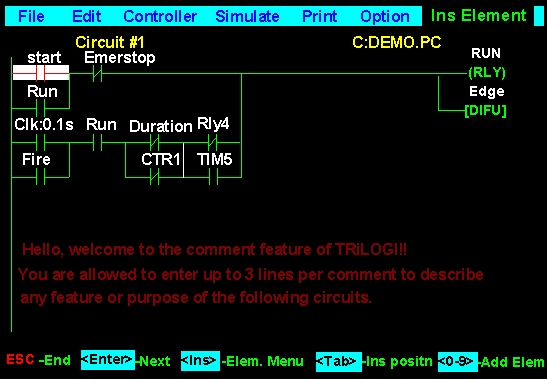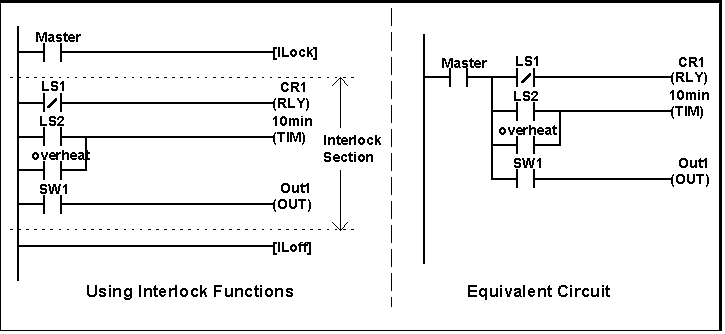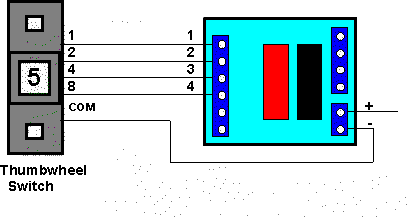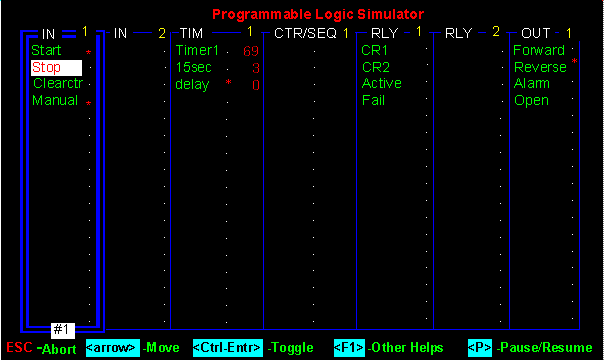 E10-npn
- Software Features and Programming Methods
Although E10-npn PLC looks deceptively simple
like many other single-chip micro based controller board, its greatest difference comes
from its programming method. E10-npn is
programmable using the "Relay-Ladder Logic" language which is the most popular
programming language used by all major manufacturer of PLCs such as Allan-Bradley, Siemens
AG and OMRON, etc. Although programs written in Relay Ladder Logic cannot directly
manipulate the microcontroller's internal hardware as easily as the assembly language,
such programs are however much easier to write and are generally understood by all
electricians around the world who need not have any knowledge about microcontrollers at
all.

Fig 1 - TRiLOGI Editor Screen
Thanks to our extremely powerful yet very user-friendly Relay
ladder logic editor-cum-simulator software - TRiLOGI, programming E10-npn become an almost
trivial task. TRiLOGI runs on any IBMPC compatible computer and provides complete
pull-down menus, pop-up windows and on-line context-sensitive help systems. As you may
observe from the above screen, you can see that all I/Os may be defined using very
meaningful names such as Start, Stop, etc. in the program and the relationship between
each I/Os are defined by how the imaginary "current" could flow through the
circuit connection.
The following sections describe the main features of TRiLOGI
including the types of functions it supports.
1. Insert Element Menu
- To add an element to the ladder diagram, you simply press the
<Ins> key and pick an item from the Insert Element pull down menu as shown above.
This menu lets you create Normally-Open (NO) or Normally-Closed (NC) contacts in series or
in parallel. One or more coils can be connected by choosing Item "7" or
"8". To insert a special function, select Item "9" or "0"
(for multiple function) and the special function menu will appear as described in the next
section.
2. Special Function Menu
[RSctr] - This function resets the counter to inactive state.
- [StepN - You can set the step counter of Sequencer #1 to any
integer value between 0 and 31. Sequencer #1 uses Counter #1 as its step counter.
- [Latch],[Clear] - When activated, the associated output or
internal relay will remain ON until it is reset by the [Clear] function acted on the same
output or relay.
[Ilock],[ILoff] - This is equivalent to a master relay with
sub-branches as illustrated below:

Figure 4: [ILock] function & its
Equivalence
- [DIFU]-The associated relay will turn on for one scan time
when its execution condition goes from OFF to ON.
- [DIFD]-The associated relay will turn on for one scan time
when its execution condition goes from ON to OFF.
[LDHex] - Set the present value of Counter
#1 to the 4-bit binary value formed by Inputs #4,3,2 & 1 where Input #4 is the most
significant bit. Typical application as follow:

Fig 5 - Using the [LDHex] function
3. Special Bits Menu
- Clock Pulse - Two clock pulses with period of 0.01s and 1.0s
are available on the E10. They can be used as a NO or NC contact in the ladder diagram.
- Sequencer 1 - E10 supports one sequencer, and each step of the
sequencer can be used as a contact in the ladder diagram. E.g. Seq1:5 represents Step #5 ,
which means that the contact with the name "Seq1:5" will be turned ON when the
step counter of the sequencer reaches the value of '5' and will be OFF when the step
counter is at any other value. The sequencer supports up to 32 steps (Step #0 to Step
#31).
4. Real Time Simulation

Fig 7 - Real Time Simulator Screen
While constructing your ladder program you can simulate it
using TRiLOGI's unique real-time Simulator. When you invoke the Simulator, you will see a
full screen of I/Os organized into 7 columns:
The first two columns show Inputs, followed by Timers,
Counters/Sequencer, Internal Relays and Outputs. Beside each I/O, an indicator lamp
indicates whether the I/O is ON or OFF. You can move the highlight bar to any I/O and
press the <Enter> key to toggle its status and the status of all the other I/Os will
be immediately updated according to the ladder program. A red "*" symbol means
an I/O is ON whereas a grey "." means it is OFF.
5. On-Line Monitoring and Control
- TRiLOGI can monitor the status of all the I/Os, Timers and
Counters of the PLC via its RS232C port. It also permits you to pause the PLC and remotely
forced-set or reset any I/Os or even modify the current value of the internal Timers and
Counters. The I/O status can either be monitored on a full screen display similar to the
Simulator-screen, or directly on the ladder diagram. This feature helps greatly during
debugging and fine-tuning of your ladder program.
6. Use of Meaningful Label Names
- In TRiLOGI all the I/Os must be defined with unique label
names prior to using them to construct the ladder program. Up to 8 characters of
alpha-numeric names can be defined which means you can create ladder diagram using far
more meaningful names such as "Start" and "Fire" instead of 001, 205
etc. Once defined, the I/O names will be used throughout the entire session of program
creation, simulation and monitoring. Any experienced programmer would be know that a
program with meaningful names is far easier to create, debug and maintain than one made up
of numbers only. Coupled with the powerful Simulator, you have to try it to believe how
easy it is to develop your control program using TRiLOGI !
7. Password to Protect Intellectual Property
- TRiLOGI allows you to set password protection on the target
PLC to prevent unauthorized uploading of your ladder program.
©
Copyright 2012 Triangle Research International, Inc.
All Rights Reserved |